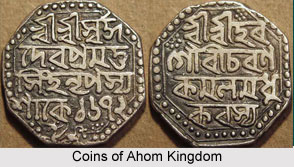 Supaatphaa was the ruler of Ahom kingdom from 1681 to 1696 AD. He was previously known as Gadadhar Singha and owns the credit of establishing the rule of the Tungkhungia clan in the kingdom. This clan ruled till the end of Ahom kingdom.
Supaatphaa was the ruler of Ahom kingdom from 1681 to 1696 AD. He was previously known as Gadadhar Singha and owns the credit of establishing the rule of the Tungkhungia clan in the kingdom. This clan ruled till the end of Ahom kingdom.
Supaatphaa was born to Gobar Roja, a former Ahom king. Supaatphaa stabilized the turmoil that prevailed in the kingdom after the victory of Ahoms in the battle of Saraighat. He also succeeded in regaining their possession over Guwahati by taking it back from Mughals. He also involved in a conflict with the Vaishnava sattra and paved way for his son, who was the succeeding king, to make Ahom kingdom the most flourished one. He made Barkola the capital of the kingdom.
Exile of Supaatphaa
The father of Supaatphaa, Gobar Roja, was killed by Atan Burhagohain after a successful expedition against the barbaric officer Debera Borbarua. In 1679 Atan Burhagohain was murdered by Laluk Sola Borphukan, who later crowned Sulikphaa Lora Roja as the Ahom king. By this act Laluk Sola Borphukan tried to gain authority over the kingdom. Afterwards he started a campaign against the Ahom princes who had the eligibility to become the king and began wounding them. To safeguard himself from this, Gadadhar Singha escaped to a region of Naga Hills which was inhabited by the Konyak Naga. Meanwhile, his wife Sati Joymati was brutally tortured and killed by the officers of Laluk Sola Borphukan and Sulikphaa.
The two years long exile of Gadadhar Singha has not been discovered clearly. However a number of legends and folktales are prevalent in the hills. According to a legend, Gadadhar Singha was gravely depressed by the death of his wife Jaimoti. To save him from the misery, his well wishers got him married with a Konyak girl, Watlong. Unfortunately Watlong also died while delivering their child at a place known as Naginimora. Afterwards, his friends again got him married with Zinyu who was a beautiful girl from Naga Hills.
Administration of Supaatphaa
When Gadadhar Singha was about to be coronated as the king, the state Ahom kingdom was highly disturbed owing to internal conflicts. Mughals had once again taken the possession of Guwahati and many of the officers joined Mughal army who were gradually proceeding towards the east. After becoming the king, adopting the name Supaatphaa, he firstly took up the task of strengthening the Ahom army against the Mughals. In the first attack, Kajali and Bansbari forts collapsed and near Bar Nadi the Ahoms achieved a great victory in the battle with Mughals. In the year 1682 Supaatphaa recaptured Guwahati which ended the eighty years long conflict of Mughals and Ahoms and Mughals were chased up to the Manas River. This marked the last battle between the two after which both accepted Manas River as their boundary.
During his reign, Nagas were also the cause of a great disturbance in the kingdom as they started raiding the Assamese villages along the border areas. To restore peaceful relations with Nagas, Supaatphaa started matrimonial alliances with them. He himself married a Naga girl with enchanting beauty named Sentishila who was the daughter of a Naga warrior.
Civil Works of Supaatphaa
By religion, Supaatphaa was a Shaivite. To propagate this religion, he also constructed a Shiva temple known as Umananda temple at the Peacock Island situated in middle of Brahmaputra River at Guwahati. Supaatphaa had a keen interest in civil works and his contributions included the construction of Dhodar Ali, Aka Ali and many other roadways. Stone bridges and tanks were also built during this period. He also began the detailed survey of the country. During his exile, Supaatphaa also got acquainted with the Mughal`s land measurement system and implemented a similar system in his kingdom. Surveyors from Bengal and Koch Behar were brought to the kingdom. The system began from Sibsagar and proceeded at a fast pace but could not be finished until the death of Supaatphaa.
Death of Supaatphaa
After the reign of about fourteen years, Supaatphaa died in February 1696. He had two sons namely Lechai and Lai. Lai, being the elder, succeeded the throne after Supaatphaa and took the kingdom to its zenith.



















